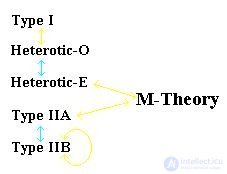Lecture
The Superstring Theory is a supersymmetric generalization of string theory.
There are five different versions of superstring theory: type I, type IIA, type IIB, and heterotic string theory based on the SO (32) groups (O-heterotic strings) and E 8 × E 8 (E-heterotic strings). Many of the basic properties of these theories are the same: vibrational modes determine masses and charges, the total number of spatial dimensions is 10, their convoluted dimensions must be Calabi – Yau manifolds, etc. The differences between them lie in the fact that supersymmetry is differently implemented and There are significant differences between the permissible vibrational modes.
| Type of | State of emergency 1 | Characteristic |
|---|---|---|
| I | ten | Includes supersymmetry; strings both open and closed; no tachyon; group symmetry - SO (32) |
| IIA | ten | Includes supersymmetry; strings only closed; no tachyon; massless hermione non-chiral |
| IIB | ten | Includes supersymmetry; strings only closed; no tachyon; massless hermione are chiral |
| HO | ten | Includes supersymmetry; strings only closed; no tachyon; heterotic theory: strings, oscillating clockwise, differ from strings, oscillating against; group symmetry - SO (32) |
| He | ten | Includes supersymmetry; strings only closed; no tachyon; heterotic theory: strings, oscillating clockwise, differ from strings, oscillating against; group symmetry - E 8 × E 8 |
| 1 Number of spacetime measurements | ||

Oscillatory excitations along a string loop can spread clockwise and against it. The string theories of types IIA and IIB differ in that in theory IIB, oscillations in both directions are identical, and in IIA they are opposite in shape. In addition, in the IIB theory, it turns out that all particles rotate in the same direction (they have the same Chirality), and in the IIA theory - in different directions (they have different chirality).
Two heterotic theories have similar, but more significant differences. All clockwise oscillation modes look the same as the type II string modes (if we consider clockwise oscillations, the theories of type IIA and IIB superstrings are identical), but counterclockwise oscillations coincide with oscillations of the boson string theory. Thus, in heterotic strings, counterclockwise modes exist in 26 dimensions, and oscillatory modes clockwise in 10. Additional boson measurements can be twisted into different Calabi – Yau manifolds, leading to theories of O- and E-heterotic strings. Since the additional boson measurements are compactified, each of these theories turns out to be as if there were 10 measurements in it, that is, as theories of type II superstrings. In heterotic theories, a certain variant of supersymmetry is also realized.
The theory of strings of type I is similar to the theory of IIB, except that in addition to closed strings there are strings with free ends, called open strings.
Comments
To leave a comment
String Theory and Superstrings
Terms: String Theory and Superstrings